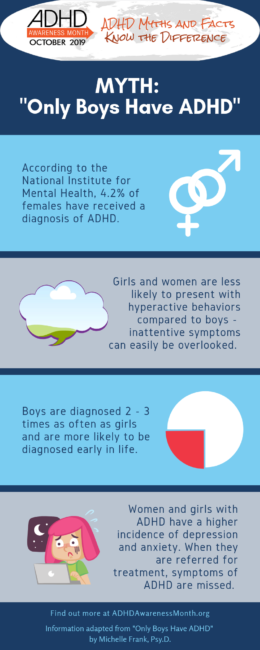FACT: Boys are diagnosed two to three times as often as girls, but about 4.2% of girls have received a diagnosis of ADHD at some point in their life (and that’s not none!).
Since ADHD was first studied in the late 1700’s, it has predominantly been studied in boys: white, hyperactive, school-aged boys, to be specific. While research on girls and women is growing at exponential rates, the myth that ADHD is a condition of boyhood has gotten in the way of adequate diagnostic and treatment services for millions of girls and women with ADHD over the centuries (yes, centuries).
According to a prominent study by the National Institute for Mental Health in 2011, about 4.2% of females have received a diagnosis of ADHD at some point in their life. However, we are still learning whether these numbers actually reflect incidence or whether rates of diagnosis for girls and women continued to be under reported.
Boys are diagnosed two to three times as often as girls, and they are also more likely to be diagnosed early in life. Researchers are currently investigating whether there is a true difference in incidence of the condition between males and females, or whether differences in rates of diagnoses are due to other factors such as gender bias or variations in presentation of symptoms.
Overall, however, women and girls are less likely to be properly diagnosed with ADHD, with boys and men being more likely than girls and women to be referred for services even when their symptom profiles are exactly the same.
Not all people with ADHD are hyperactive
The myth that all people with ADHD are hyperactive likely accounts for another reason that girls and women with the condition go overlooked.
Girls and women are less likely to present with hyperactive or externalizing behaviors compared to boys and are more likely to be diagnosed with the Predominantly Inattentive Presentation of the condition. Inattentive symptoms can easily be overlooked or misperceived and are less likely to lead to a referral for evaluation. Inattentive symptoms, for instance, are less likely to cause a classroom disturbance that gets the teachers’ attention. Further, clinicians and researchers are beginning to wonder if current diagnostic criteria accurately reflect the condition for girls and women.
Women and girls with ADHD have a higher incidence of depression and anxiety. This could, in part, be due to a tendency of girls and women to exhibit internalizing behavior while boys and men in general are more likely to display behaviors that are more externalizing.
Many are initially referred for treatment due to symptoms of anxiety and depression, while symptoms of ADHD are missed. A number of complex and nuanced factors further influence the female experience of ADHD, including fluctuating estrogen levels impacting symptoms and gendered expectations of behavior that might complicate how symptoms are perceived.
ABOUT THE AUTHOR

Dr. Frank is a licensed clinical psychologist specializing in providing diagnostic and treatment services to individuals with ADHD. Dr. Frank is the co-author of A Radical Guide for Women with ADHD: Embrace Neurodiversity, Love Boldly, and Break Through Barriers, written in collaboration with Sari Solden and published by New Harbinger. Dr. Frank has been an active member of both ADDA and CHADD and has presented both locally and nationally on ADHD, women’s issues, and neurodiversity.
References
https://www.nimh.nih.gov/health/statistics/attention-deficit-hyperactivity-disorder-adhd.shtml
https://www.tandfonline.com/doi/abs/10.1080/15374410903103627

